COVID-19 Explained
Your questions, answered
How many confirmed cases are there in the US? (latest numbers)
 United States
United States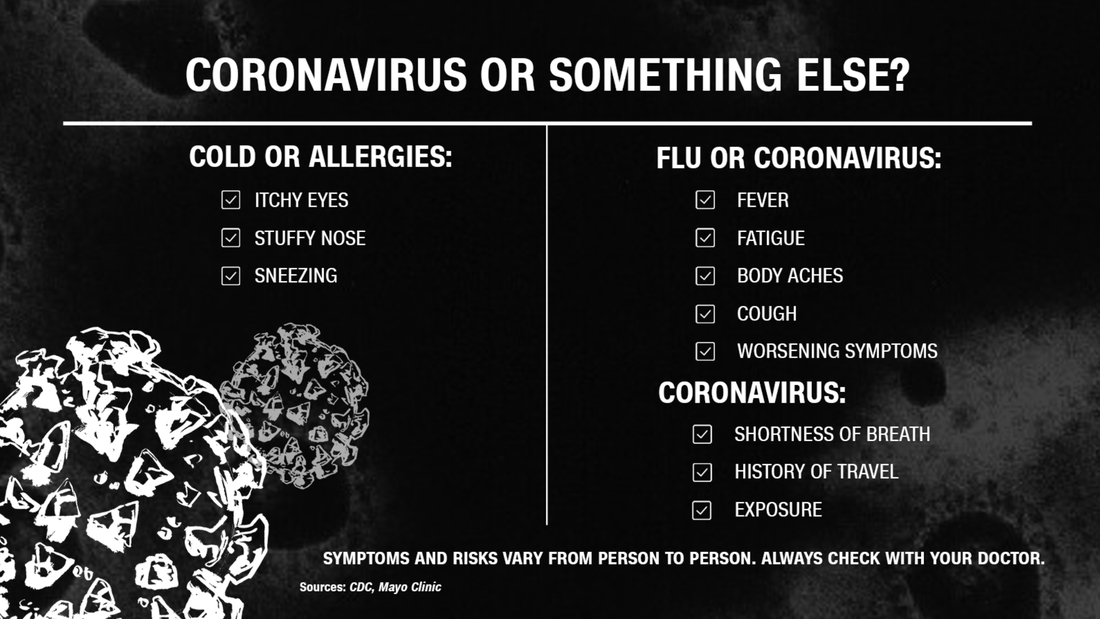 In early stages of the illness, the symptoms are the same as a cold or the common flu. However, the main distinction seems to be shortness of breath,
and some also have severe diarrhea, this is where things begin to go downhill quickly. Get help.
In early stages of the illness, the symptoms are the same as a cold or the common flu. However, the main distinction seems to be shortness of breath,
and some also have severe diarrhea, this is where things begin to go downhill quickly. Get help.
- there is no vaccine nor known cure for Covid-19, while we have flu shots that prevent us from getting known flus
- while equally contagious, and possess similar symptoms, covid-19 and the common flu differ in terms of death rate and hospitalization rate. The death rate for the common flu is less than 0.1%, while the covid-19 patient's death rate is between 2% (China) to 7%(italy)
- In terms of hospitalization rate, most common flu patients can recover without hospitalization or treatment, while 20% covid-19 patients have severe symptoms that would need hospitalization, and many require ventilators to help with breathing.
- While anecdotal at this point, there are many stories where patients of covid-19's condition goes downhill very quickly because covid19 acts like SARS (cause breathing problems) and AIDS (breaks down your immune system) at the same time. The high death rate (compared with common flu) indirectly supports this, since most these patients die in hospitals where in normal situations doctors should be able to provide treatments to keep them alive.
- while less deadly than SARS, MERS or Ebola, CoVID-19 is much more contagious, but more more deadly than the common flu (between 10X to 60X depend on how it is calculated). Unlike SARS, MERS that are mostly only contagious when patients begin to exhibit strong symptoms, CoVID-19 is highly contagious when the infected is asymptomatic.
- While it exhibits very similar symptoms as the common flu in the early stages, is often neglected by patient and can easily pass onto other people as a result.
- The common flu we have vaccines and known medicines that can alleviate the symptoms, for CoVID-19, we have neither.
- While we have some ideas of how it transmits, it is still not fully understood (scientists are learning new things every day), more on this later. But the point is, there are a lot of unknowns, which makes it difficult to prevent. Even the experts in the field (who supposedly know everything there is to know about prevention) got the virus, it just shows how contagious it is and how easily it can slip pass our guards.
- About 20~30% of the patients needs hospitalization and care, many need ventilators to survive. With its contagious factor, it can easily infect millions of people, 20~30% means 200~300K patients require hospital beds and ventilators, it can easily overwhelm any country's healthcare system, causing severe to critical patients unable to acquire care or proper treatment, dramatically increasing the risk of infection for healthcare workers to work in this situations, which leads into a downward spiral that causes much higher death rate than what the current death rate stats show (2~3%). This is what happened in Wuhan, the epidemic center of China. In Wuhan, the death rate was 4~5%, compared with less than 1% in the rest of China.
The novel corona virus is a new virus, that researchers are still learning more about every day. While all of the ways
that it can be transmitted are not fully understood, majority of the experts agree that droplets infection is the main way that Covid-19
is transmitted, which means coughs, sneezes, sweat, tears, saliva are the main ways that the virus can be passed onto you.
With regard to airborne nature of the virus, while there has been long reported by Chinese researchers that covid-19 can be transmitted via
air particles, it has only been recently confirmed by WHO that Covid-19 virus can stay alive in the air for upto 8 hours (source), and there
are indeed cases of airborne infection (source). However, you and I still don't need to worry about the airborne infection because current
evidence seems to suggest these cases are rare and are mostly observed in situations where special medical procedures would generate aerosols
that contains the virus. Air breathe by the an infected patient would not cause air contamination. It is however a must that those who have
been tested positive (even ones who do not exhibit symptoms) maintain strict self-quarantine as they are highly contagious because anything
they cough or sneeze on, or even touches become a contagion since the virus can live on many surfaces for hours to even days.
Update 4/6/2020: Here's some more visualization to show you why even if not airborne,
you'll still would want something to coverup
your face to protect you against droplet infection, and why simply keeping a 6 feet safe distance is not enough
@tivul2 ##coronavirus ##covid19 ##reallifeathome ##young ##mom ##dad ##scaryfacts ##distancedance
♬ Falling - Trevor Daniel
-
If we just look at death rate, young and healthy people probably do not need to worry at all. However, things aren't that simple: if we look at other metrics,
it is much more worrysome, even for young and healthy individuals:
40% of the people gets hospitalized are from the age group of 20~50,
you can see more of the breakdown of age-groups in the chart below. But the bottom line is, while the virus won't kill you, it has good
chance of messing you up and that you will need hospitalization. If the curve is not flattened, your chance for survival will be
dramatically lowered too.
 Data above shows, 20% of the young patients that tested positive (age:20-44) require hospitalization, ICU cases is about 4%. This is not a small number.
Also, this number is when our medical system has not been overwhelmed yet. Don't let it get to that.
Data above shows, 20% of the young patients that tested positive (age:20-44) require hospitalization, ICU cases is about 4%. This is not a small number.
Also, this number is when our medical system has not been overwhelmed yet. Don't let it get to that. - Another perspective is that even if you don't get severely sick, you walking around with the virus can easily infected your parents or grand parents, or somebody else's grandparents, who's going to get it much much worse. It's not about you.
- A third point is that there are studies that shows about
20% of patients who do recover from the disease exhibited long term damages to their
lungs. Although the dataset is not quite big enough to give a definitive statement, the preliminary results is alarming enough that
for EVERYONE (both young and old) to take this more seriously.
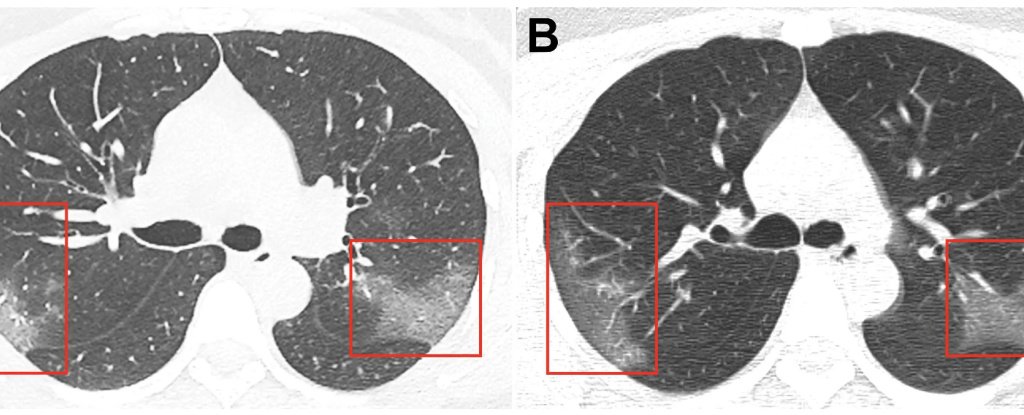
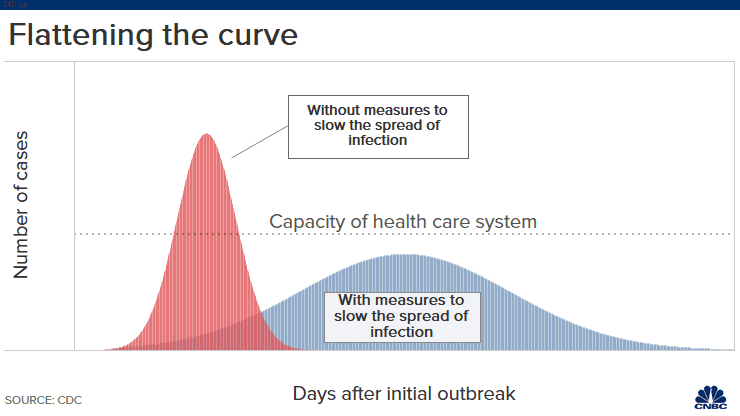 source:
Flattening the curve, and why it is important
source:
Flattening the curve, and why it is important
In short, if left unchecked, the Covid-19 spread will undoubtedly cripple our healthcare system: Shortages of hospital beds, necessary equipment such as ventilators to keep severe patients alive (20% of the infected cases), Also shortages protective gear for doctors and nurses to keep them healthy etc.. If that happens, a lot more people will die. The death rate will not be 1~2% any more. This is what happened initially in Wuhan, where its death rate is much greater than the rest of China. Don't let it come to that. Let's flatten our curve. For more information, please read the article Flattening the curve, and why it is important
A quick answer is no, not by a long shot
To answer this question properly, let's take a look at the curves from other countries that have been
through this
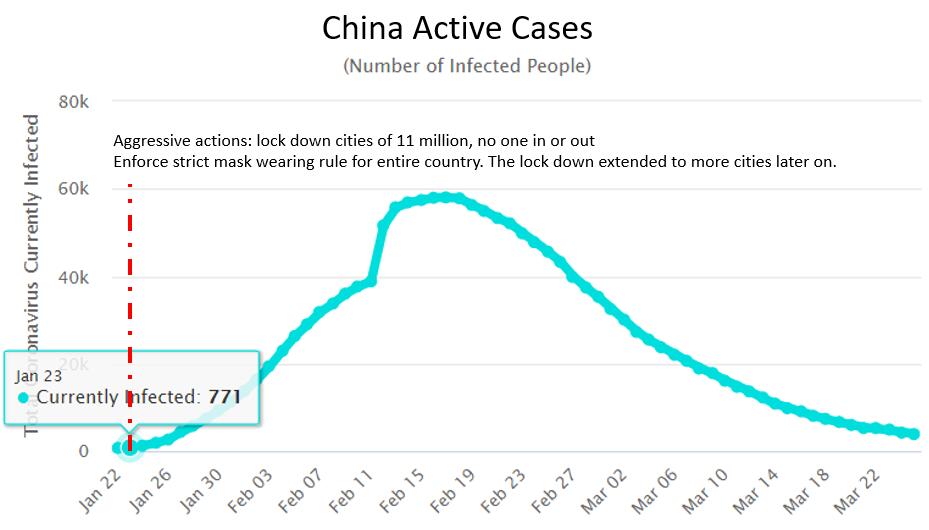 China took agressive actions and began locking down cities since 1/23, and started locking down
rest of the country starting luna new year which is between 1/26 to 1/30. The curve did not go flat
for China until a month later when new cases begin to drop. The epicenter city Wuhan is still currently
(3/26) in lock down mode. Although lock down has been relaxed where people are allowed to leave their
homes for grocery shopping, compared to before food were delivered to each by volunteers and military
personnels
China took agressive actions and began locking down cities since 1/23, and started locking down
rest of the country starting luna new year which is between 1/26 to 1/30. The curve did not go flat
for China until a month later when new cases begin to drop. The epicenter city Wuhan is still currently
(3/26) in lock down mode. Although lock down has been relaxed where people are allowed to leave their
homes for grocery shopping, compared to before food were delivered to each by volunteers and military
personnels
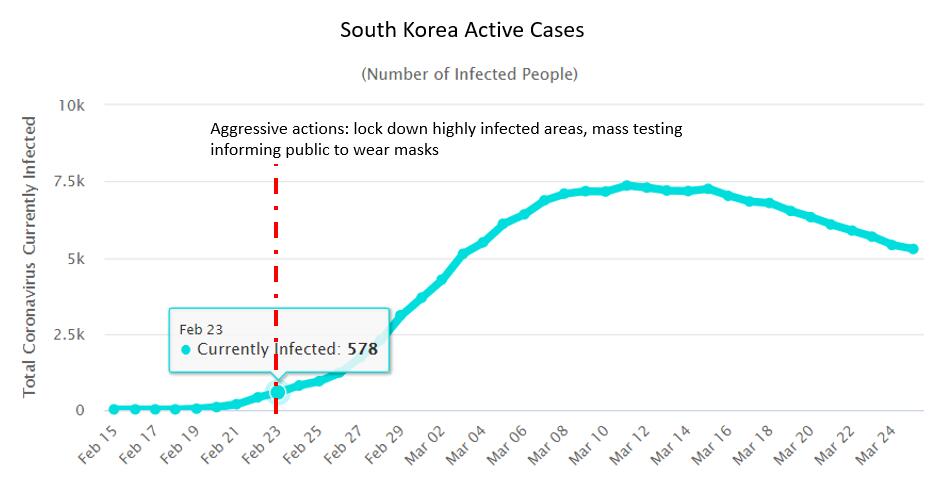 South Korea was the second country to experience a massive increase of confirmed case, but they took
agressive actions early on
and banned all gatherings, and locked down infected regions that were cause of the initial outbreak.
Its curve were very quickly flattened, the peak of the curve remains relatively low. Korea serves
as a successful example of containing the outbreak.
South Korea was the second country to experience a massive increase of confirmed case, but they took
agressive actions early on
and banned all gatherings, and locked down infected regions that were cause of the initial outbreak.
Its curve were very quickly flattened, the peak of the curve remains relatively low. Korea serves
as a successful example of containing the outbreak.
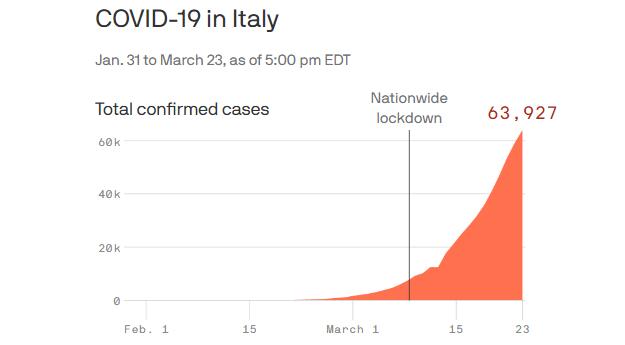 Italy, unfortunately, was not so lucky. The outbreak quickly got out of control, and the number rose
exponentially, and despite taking agressive actions where the entire country was locked down since 3/9, the curve
still has not been flattened yet. The question is why? Comparing the data, one can speculate that
Italy, unfortunately, was not so lucky. The outbreak quickly got out of control, and the number rose
exponentially, and despite taking agressive actions where the entire country was locked down since 3/9, the curve
still has not been flattened yet. The question is why? Comparing the data, one can speculate that
So, in comparison, how did the US do? (see graph below) Unfortunately, we did even worse than italy. Not only did we repeat all of the mistakes italy made (slow to react and underestimating the serverity of the virus - many, from government official to celebrities believed it's no worse than the common flu), the US was very slow in testing the population to identif the infected cases. The ramp of test kits were very slow since the outbreak broke out, much slower than Korea, and also italy. As a result, the numbers in the US grew even more drastically than italy: it only took US 15 days to go from less than 100 cases to reach 83,000, surpassing even China in the number of confirmed case.
So, sadly, the answer is that we are NOT out of the woods yet, this is only the beginning, because we are only beginning to catch up with the testing capabilities. With the increase of testing capability, as we have seen in other countries, the number will only rise because we are now finally able to identify the infected portion of the population.
 China took agressive actions and began locking down cities since 1/23, and started locking down
rest of the country starting luna new year which is between 1/26 to 1/30. The curve did not go flat
for China until a month later when new cases begin to drop. The epicenter city Wuhan is still currently
(3/26) in lock down mode. Although lock down has been relaxed where people are allowed to leave their
homes for grocery shopping, compared to before food were delivered to each by volunteers and military
personnels
China took agressive actions and began locking down cities since 1/23, and started locking down
rest of the country starting luna new year which is between 1/26 to 1/30. The curve did not go flat
for China until a month later when new cases begin to drop. The epicenter city Wuhan is still currently
(3/26) in lock down mode. Although lock down has been relaxed where people are allowed to leave their
homes for grocery shopping, compared to before food were delivered to each by volunteers and military
personnels
 South Korea was the second country to experience a massive increase of confirmed case, but they took
agressive actions early on
and banned all gatherings, and locked down infected regions that were cause of the initial outbreak.
Its curve were very quickly flattened, the peak of the curve remains relatively low. Korea serves
as a successful example of containing the outbreak.
South Korea was the second country to experience a massive increase of confirmed case, but they took
agressive actions early on
and banned all gatherings, and locked down infected regions that were cause of the initial outbreak.
Its curve were very quickly flattened, the peak of the curve remains relatively low. Korea serves
as a successful example of containing the outbreak.  Italy, unfortunately, was not so lucky. The outbreak quickly got out of control, and the number rose
exponentially, and despite taking agressive actions where the entire country was locked down since 3/9, the curve
still has not been flattened yet. The question is why? Comparing the data, one can speculate that
Italy, unfortunately, was not so lucky. The outbreak quickly got out of control, and the number rose
exponentially, and despite taking agressive actions where the entire country was locked down since 3/9, the curve
still has not been flattened yet. The question is why? Comparing the data, one can speculate that
- italy took agressive action too late (3/9 at over 9000 confirmed cases), such that it only began forcing citizens to quarantine and lock down cities after the confirmed cases number has drastically risen, by then, large number of people infected was already spreading the virus every where, making it impossible to contain. In comparison, Korea took agressive action 1 week (2/23 at 602 confirmed cases) after the apparence of the first case, and very quickly tested and IDed the positive cases and isolated them.
- italy being an european country, unlike Asian countries such as China, Japan and Korea, it never experienced outbreaks like SARs or MERS, its citizens are much less cautious about how to deal with outbreaks like this. When government in Japan, Korea ordered its citizens to quarantine and exercise curfew and wear masks, people listened and executed very well. Whereas italy, even after government issued a strict lock down order, people still go out for coffee and gathered in groups, very few wore masks to protect themselves. As a result, italy is still experiencing an exponential increase of confirmed case, even after 3 weeks of lock down. Many cities hospitals are at maximum capacity. Its death rate is the highest amongst all nations.
So, in comparison, how did the US do? (see graph below) Unfortunately, we did even worse than italy. Not only did we repeat all of the mistakes italy made (slow to react and underestimating the serverity of the virus - many, from government official to celebrities believed it's no worse than the common flu), the US was very slow in testing the population to identif the infected cases. The ramp of test kits were very slow since the outbreak broke out, much slower than Korea, and also italy. As a result, the numbers in the US grew even more drastically than italy: it only took US 15 days to go from less than 100 cases to reach 83,000, surpassing even China in the number of confirmed case.
So, sadly, the answer is that we are NOT out of the woods yet, this is only the beginning, because we are only beginning to catch up with the testing capabilities. With the increase of testing capability, as we have seen in other countries, the number will only rise because we are now finally able to identify the infected portion of the population.
US confirmed and new cases time-line
According to the data and analysis from above, our current best frame of reference is China, which took 3 weeks from
it initiated the lockdown before the curve was finally flattened. It took longer for the curve to drop down.
US however, has just surpassed China in its cumulative positive cases, which means we are in a worse state
compared with China. So it is only reasonable to guess that it will take the US longer to reach the plateau.
In order to predict when exactly the peak will arrive, the best indicator would be the new cases count. As shown in the new cases plot for China, the turning point began in 2/5, and for a number of days the new cases numbers started to consistently fall. There was a spike on 2/12, but that was due to China changed the way confirmed cases are tallied, reduce the threshold for confirmed cases, thus quarantining more aggressively the possible cases from the general public. This move accelerated the downward trend for the new cases count. Allowing China to reach the peak (flattening the curve) around 2/16, roughly 10 days after the peak for new cases.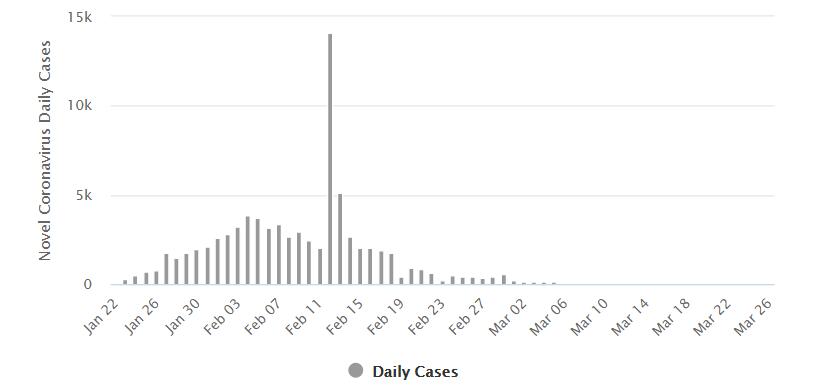
Similarly, for South Korea, the peak for new cases came on 3/3, whereas the curve plateaued around 3/11, roughly a weak after the peak for new cases.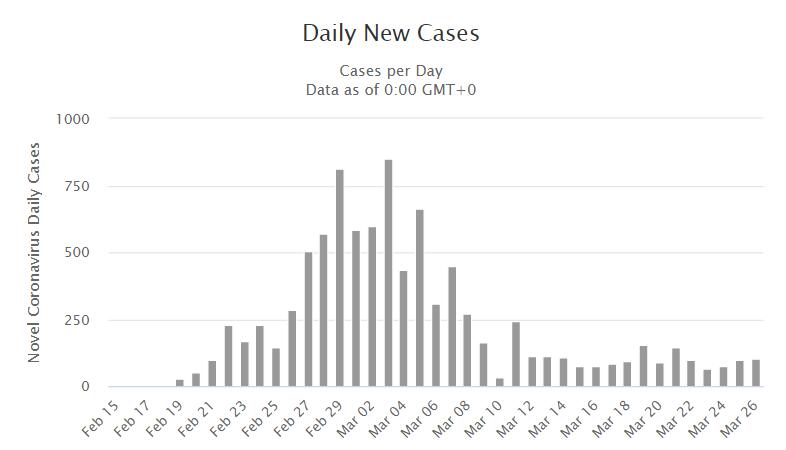
Therefore according to these 2 data points, we will be able to better predict the plateau when we see a consistent drop of new cases, and exactly how long after we reach the peak for the new cases, we will see the peak for the active cases will be somewhat proportional to the number of new cases at the time of the peak: the larger the number, the longer it will take for it to drop down. At this point, I would say it will be longer than China's 10 days.
In order to predict when exactly the peak will arrive, the best indicator would be the new cases count. As shown in the new cases plot for China, the turning point began in 2/5, and for a number of days the new cases numbers started to consistently fall. There was a spike on 2/12, but that was due to China changed the way confirmed cases are tallied, reduce the threshold for confirmed cases, thus quarantining more aggressively the possible cases from the general public. This move accelerated the downward trend for the new cases count. Allowing China to reach the peak (flattening the curve) around 2/16, roughly 10 days after the peak for new cases.

Similarly, for South Korea, the peak for new cases came on 3/3, whereas the curve plateaued around 3/11, roughly a weak after the peak for new cases.

Therefore according to these 2 data points, we will be able to better predict the plateau when we see a consistent drop of new cases, and exactly how long after we reach the peak for the new cases, we will see the peak for the active cases will be somewhat proportional to the number of new cases at the time of the peak: the larger the number, the longer it will take for it to drop down. At this point, I would say it will be longer than China's 10 days.
- Don't panic. Panicking leads to bad decisions, which leads to infection
- Wash your hands as frequently as possible with soap and water, use hand sanitizers if you don't have water or soap available
- Stay home
- If you need to go out for shopping, stay away from people, wear masks and gloves. If you don't have masks, use home-made masks, bandanas, scarves or any kind of clothing to cover up your face
- Disinfect any packages or mail coming to your house
The short answer is YES, please wear something to protect yourselves and help slow down the spread.
The key reason is that this is a new virus that we have very little knowledge of. Even experts
are changing their position and recommendations throughout the passing month since the outbreak
kicked into full gear a month ago. Here is a demonstration of how clueless the experts are and
what they actually think now about face masks:
Update 4/2/2020: The Surgeon General finally changed position on the usefulness of wearing a mask, and made a video teaching
people how to do a home-made mask. A month too late, but better late than never.
All in all, I would say it's one of the best videos for home-made masks, check it out.
That said, I have seen people add another layer of airfilter material that makes even more virus proof. Want to learn more? Leave a comment.
Check out the full playlist here.
Update 4/6/2020: Here's some more visualization to show you why even if not airborne,
you'll still would want something to coverup
your face to protect you against droplet infection, and why simply keeping a 6 feet safe distance is not enough
@tivul2 ##coronavirus ##covid19 ##reallifeathome ##young ##mom ##dad ##scaryfacts ##distancedance
♬ Falling - Trevor Daniel
There are many tutorials on youtube that shows you how to make home-made masks, some are very easy to make
which while not as effective as N-95, will be useful in lowering the chances of you being
exposed to droplet infection, and in turn help slowing Covid-19 down so we can get a vaccine
or cure. Here's one of such videos for your reference
here's
a full playlist
of different ways people came up with to create home-made masks,
they vary in terms of materials used, and different level of protection, as well as
time needed to build them. Some are very easy, some are more involved,
take your pick on what works best for you and your family. But here's something
we now know for sure, wearing something is better than nothing.
Here are some extra tips on "now that I am exercising shelter-at-home, and I wear mask when I go out,
what are other things that I might miss that would bring virus into my home?"
Grocery shopping. Even though you wear masks when going to the store, every time you go out to a
semi-crowded place, you are in risk of bring back some of the virus back. What I see that people
now may miss is that they don't wear gloves, which is actually a bigger source of contamination than
not wear masks. You should also wear a layer of clothes on top of what you would wear at home so you
can leave them at your garage. When you get home, leave the non-essential grocery in the garage, and
use disinfecting wipes to wipe down your meat or other stuff that might go bed quickly before you
bring them in. Here's an article that would explain this in more detail
and a youtube video that tells you how to clean your grocery properly
Credit card and cash. Covid19 can survive on many surfaces for hours or even days. Depending
on how you pay for your shopping, you may unwittingly bring back virus to your home through
these payment methods. Before China's numbers came down, they almost tried to clean every
single bill in China because that could be a source of transmission. But the numbers came
down soon after the idea was floated around, so I don't think that initiative got much
traction. Another point why this is a problem for the US, more so than China is that 90% of
Chinese already use their phones to make payments for everything. So paper money is actually
rarely used now. But here, I think many people still use paper money. So, use credit card if
you can, and wipe it down afterwards.
Your cellphone. Don't check your phone every 2 minutes when you go out. Print out a shopping list
instead and toss it away afterwards. We carry our phones everywhere, and even I haven't gotten
into the habit of wiping my phone yet. I imagine this is going to hard for everyone. So be careful.
Your mails. I think most people already know to spray their amazon packages. But mail
is also another source that people haven't talked much about. I hear that many USPS
workers have gotten sick, before the mask and glove wearing mechanisms were put into
place to protect them. So wipe down your mail as well.
You can make them yourselves easily using ingredients found at home
Both testing and treatment have been made free, but there are other medical costs involved that can be avoided.
Please read this article ahead of time,
so you can avoid a large surprising bill.


